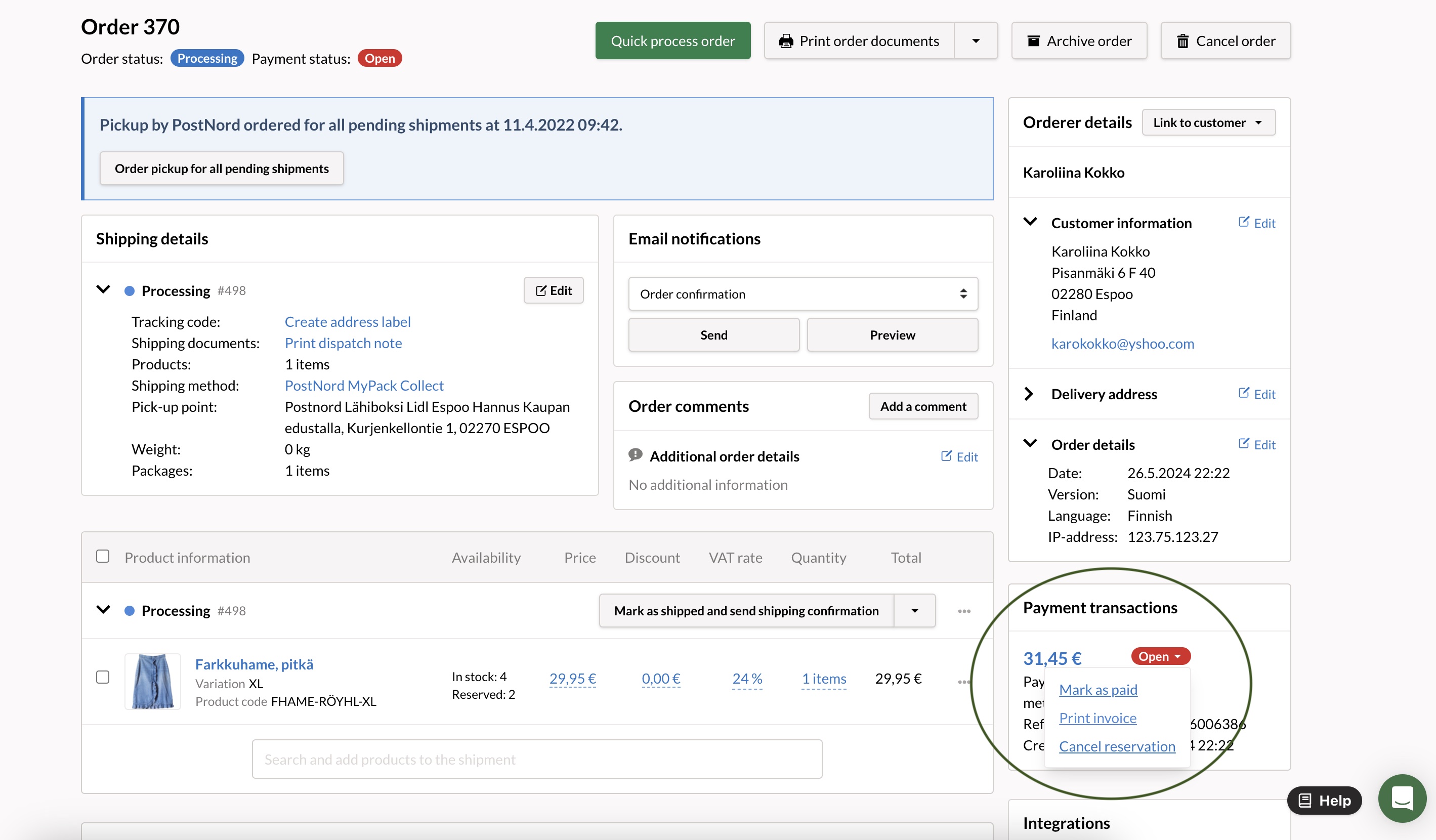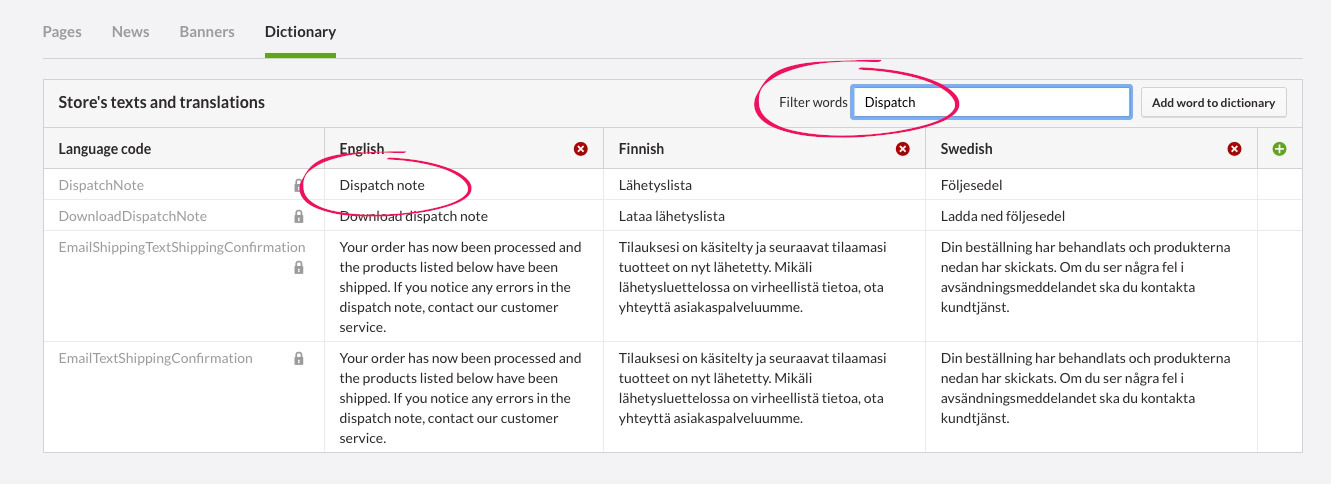MyCashflow automatically creates PDF order documents for each order (e.g. shipping labels, invoices and receipts) and email messages that can be sent automatically or manually. Here we discuss order documents, emails and comments as well as how to use them during order processing.
Order and shipping documents
In MyCashflow, several printable PDF documents are available for orders and their individual shipments:
- order documents contain information on the full content of the order
- shipping documents contain information about the content of a single shipment
- payment transaction documents( invoices for orders using theMyCashflow Invoice payment service).
Downloading and printing order and shipping documents
Below we will go through the printing of order and shipping documents and invoices.
Order documents
The following documents apply to the entire content of the order:
- receipt
- dispatch note
- return form
How to download and print order documents:
By default, the PDF file contains all order documents. To print or download only part of them, press the down arrow next to the the button and select the document or documents you want.

Shipping documents
The following documents concern the content of a single shipment within an order:
- dispatch note
- osoitekortti
- customs documents
- CN22 slip (small customs declaration)
- CN23 slip (large customs declaration)
- commercial invoice
Customs documents are only available if the shipment needs to be cleared and the selected delivery service supports the definition of customs clearance information. Read more about the use of customs clearance data in MyCashflow online shops.
Customs lists CN22 and CN23 are available for OmaPosti Pro and CN23 is also available for nShift eCom Pro and Lite. Find out more about customs tariffs for parcels and letters on the Posti website.
Here's how to create and print shipment-specific documents:
If the contents of the shipment change before shipping, create new shipping documents by deleting the shipment's tracking code.
Payment transaction documents
If your order uses the MyCashflow Invoice payment service, you can open the PDF invoice for printing in the Payment transactions section on the right-hand side of the order page.
Invoices from other payment services cannot be printed directly through the admin panel.

MyCashflow also includes tools for bulk order processing and bulk printing order documents (available starting from the MyCashflow Advanced plan).
Editing order documents
You can edit the contents and design of all order documents generated by MyCashflow. Only the shipping labels provided by logistics integrations cannot be edited with MyCashflow tools, but the logistics services may provide their own tools for this purpose.
Editing document contents and texts
Documents' fixed texts are retrieved from the online store's dictionary and settings. Whenever you edit texts retrieved from the dictionary (such as table column headers) or settings (store name, logo etc.), the changes are reflected in order documents created afterwards.
The easiest way to find dictionary texts used in order documents is to use the text that you'd like to edit as the search term.

The variable contents (such as orderer information, prices, product information) depend on the content of the order. Whenever you edit order content (e.g. add products to a shipment), the changes will be reflected in documents created afterwards.
Editing document design
The structure and layout of the documents are defined in the PDF theme. In order document templates, you can e.g. specify colors and fonts as well as document contents and details as well as their arrangement in PDF documents.
For example, an invoice is generated based on the PDF theme file invoice.html.
Editing document structure and design require editing the store theme. If you're not familiar with modifying your store theme's HTML/CSS/JavaScript files, contact the designer of your online store's theme or our customer service.
Order emails and comments
All orders are accompanied by automatic email notifications that inform the customer about the progress of the order. You can also send email notifications manually and leave optional comments on the order (for internal use or to be sent to the customer).
By default, all order emails are sent only to the email address indicated in the order's billing details. If you'd like order emails to be sent to the email indicated in the shipping address, support for this needs to be added to the online store's email theme.
Adding the support requires using HTML/CSS languages and MyCashflow's Interface markup. If you're not familiar with modifying themes, contact the designer of your store theme or the MyCashflow customer service.
Automatic email notifications
During order processing, the system typically sends the following email notifications to the customer:
- Order confirmation: a message that is always sent to the customer automatically when an order is placed.
- Shipping confirmation/Ready for pickup: a message that is sent to the customer automatically when the order is marked as shipped.
If you divide the order into multiple shipments, you can choose whether a separate message should be sent to the customer when marking a single shipment as shipped. In such case, other products will be listed in the shipping confirmation as a back order.
If support for sending messages to the shipping address has been added to the online store's email theme, you can choose in the order settings' Order emails item whether the shipping confirmation should also be sent to the shipping address. This can be useful particularly when purchasing digital gift cards, as the orderer often expects the information about the gift card to be directly conveyed to the recipient.
- Order cancelled: a message that is sent to the customer by default when the order is canceled (however, when canceling you can choose whether to send the message).
Additionally, the online store's admin is always notified when a new order arrives in the store. The message is primarily sent to the address specified in the store version settings's item . If it hasn't been specified, the message will be sent to the address specified in the Email field on the page.
Sending email notifications manually
You can also send any email notification to the customer manually from the Email notifications section on the order page.
Apart from the automatically sent order emails, there are also messages that can be sent only manually:
- Pending payment: a message to remind the customer of an unpaid payment
- Payment confirmation: a message to confirm that a payment has been received
- Delivery is delayed: a message to inform the customer of delays in order shipping
Here's how to send order emails manually:
Informal order comments
Apart from the ready email notifications with fixed contents, you can send order comments to the customer via the order page.
You can also save comments for the order so that they're not sent to the customer. In this way, different store staff members who work on the same order can leave internal comments for each other.
Here's how to leave an order comment:
Editing emails
You can edit the contents, structure and design of all of MyCashflow's order emails.
Editing email contents and texts
You can edit the texts of order emails via your online store's dictionary.
Editing email design
Emails are always sent in both HTML version and as plain text so that they can be opened in any email client.
The HTML version is based on templates included in your online store's email theme. In the email theme, you can define the design and structure of email notifications by using the HTML/CSS code, the MyCashflow Interface tags as well as the Foundation for Emails framework.
Find out more about email themes.
Editing email structure and design requires editing the store theme. If you're not familiar with modifying your store theme's HTML/CSS/JavaScript files, contact the designer of your online store's theme or our customer service.





